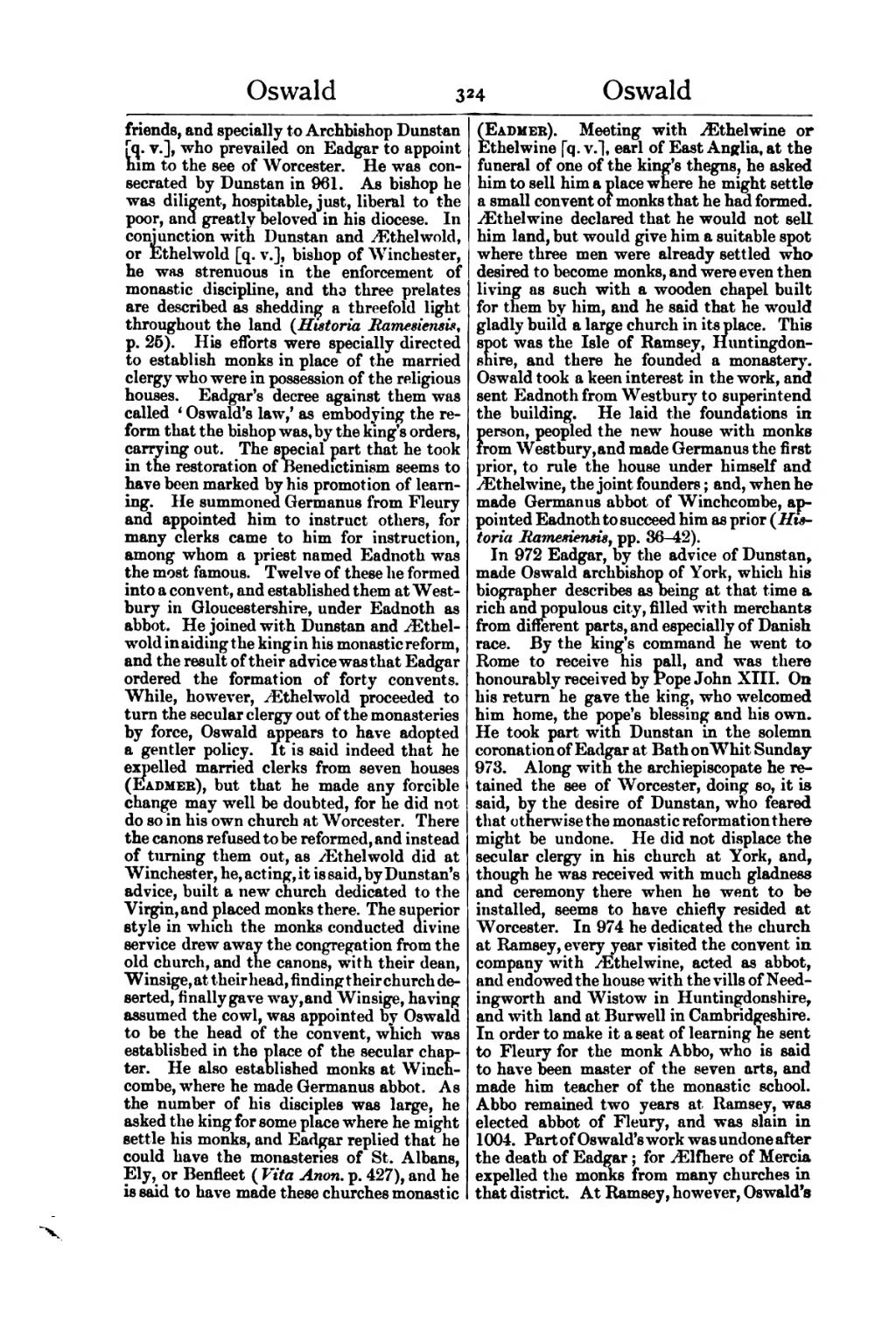friends, and specially to Archbishop Dunstan
[q. v.], who prevailed on Eadgar to appoint
him to the see of Worcester. He was consecrated by Dunstan in 961. As bishop he was diligent, hospitable, just, liberal to the poor, and greatly beloved in his diocese. In
conjunction with Dunstan and Æthelwold, or Ethelwold [q. v.], bishop of Winchester, he was strenuous in the enforcement of monastic discipline, and the three prelates are described as shedding a threefold light throughout the land (Historia Ramesiensis, p. 25). His efforts were specially directed to establish monks in place of the married clergy who were in possession of the religious houses. Eadgar's decree against them was called 'Oswald's law,' as embodying the reform that the bishop was, by the king's orders, carrying out. The special part that he took
in the restoration of Benedictinism seems to
have been marked by his promotion of learning. He summoned Germanus from Fleury and appointed him to instruct others, for
many clerks came to him for instruction,
among whom a priest named Eadnoth was the most famous. Twelve of these he formed into a convent, and established them at Westbury in Gloucestershire, under Eadnoth as abbot. He joined with Dunstan and Æthelwold in aiding the king in his monastic reform, and the result of their advice was that Eadgar ordered the formation of forty convents. While, however, Æthelwold proceeded to
turn the secular clergy out of the monasteries
by force, Oswald appears to have adopted a gentler policy. It is said indeed that he expelled married clerks from seven houses
(Eadmer), but that he made any forcible
change may well be doubted, for he did not
do so in his own church at Worcester. There
the canons refused to be reformed, and instead
of turning them out, as Æthelwold did at
Winchester, he, acting, it is said, by Dunstan's
advice, built a new church dedicated to the
Virgin, and placed monks there. The superior
style in which the monks conducted divine
service drew away the congregation from the
old church, and the canons, with their dean,
Winsige,at their head, finding their church deserted, finally gave way, and Winsige, having
assumed the cowl, was appointed by Oswald
to be the head of the convent, which was
established in the place of the secular chapter. He also established monks at Winchcombe, where he made Germanus abbot. As
the number of his disciples was large, he
asked the king for some place where he might
settle his monks, and Eadgar replied that he
could have the monasteries of St. Albans, Ely, or Benfleet (Vita Anon, p. 427), and he is said to have made these churches monastic
(Eadmer). Meeting with Æthelwine or
Ethelwine [q. v.], earl of East Anglia, at the
funeral of one of the king's thegns, he asked
him to sell him a place where he might settle
a small convent of monks that he had formed.
Æthelwine declared that he would not sell
him land, but would give him a suitable spot
where three men were already settled who
desired to become monks, and were even then
living as such with a wooden chapel built
for them by him, and he said that he would
gladly build a large church in its place. This
spot was the Isle of Ramsey, Huntingdonshire, and there he founded a monastery. Oswald took a keen interest in the work, and sent Eadnoth from Westbury to superintend the building. He laid the foundations in person, peopled the new house with monks
from Westbury, and made Germanus the first
prior, to rule the house under himself and Æthelwine, the joint founders; and, when he made Germanus abbot of Winchcombe, appointed Eadnoth to succeed him as prior (Historia Ramenensis, pp. 36-42).
In 972 Eadgar, by the advice of Dunstan, made Oswald archbishop of York, which his biographer describes as being at that time a rich and populous city, filled with merchants from different parts, and especially of Danish race. By the king's command he went to Rome to receive his pall, and was there honourably received by Pope John XIII. On his return he gave the king, who welcomed him home, the pope's blessing and his own. He took part with Dunstan in the solemn coronation of Eadgar at Bath on Whit Sunday 973. Along with the archiepiscopate he retained the see of Worcester, doing so, it is said, by the desire of Dunstan, who feared that otherwise the monastic reformation there might be undone. He did not displace the secular clergy in his church at York, and, though he was received with much gladness and ceremony there when he went to be installed, seems to have chiefly resided at Worcester. In 974 he dedicated the church at Ramsey, every year visited the convent in company with Æthelwine, acted as abbot, and endowed the house with the vills of Needingworth and Wistow in Huntingdonshire, and with land at Burwell in Cambridgeshire. In order to make it a seat of learning he sent to Fleury for the monk Abbo, who is said to have been master of the seven arts, and made him teacher of the monastic school. Abbo remained two years at Ramsey, was elected abbot of Fleury, and was slain in 1004. Part of Oswald's work was undone after the death of Eadgar; for Ælfhere of Mercia expelled the monks from many churches in that district. At Ramsey, however, Oswald's
